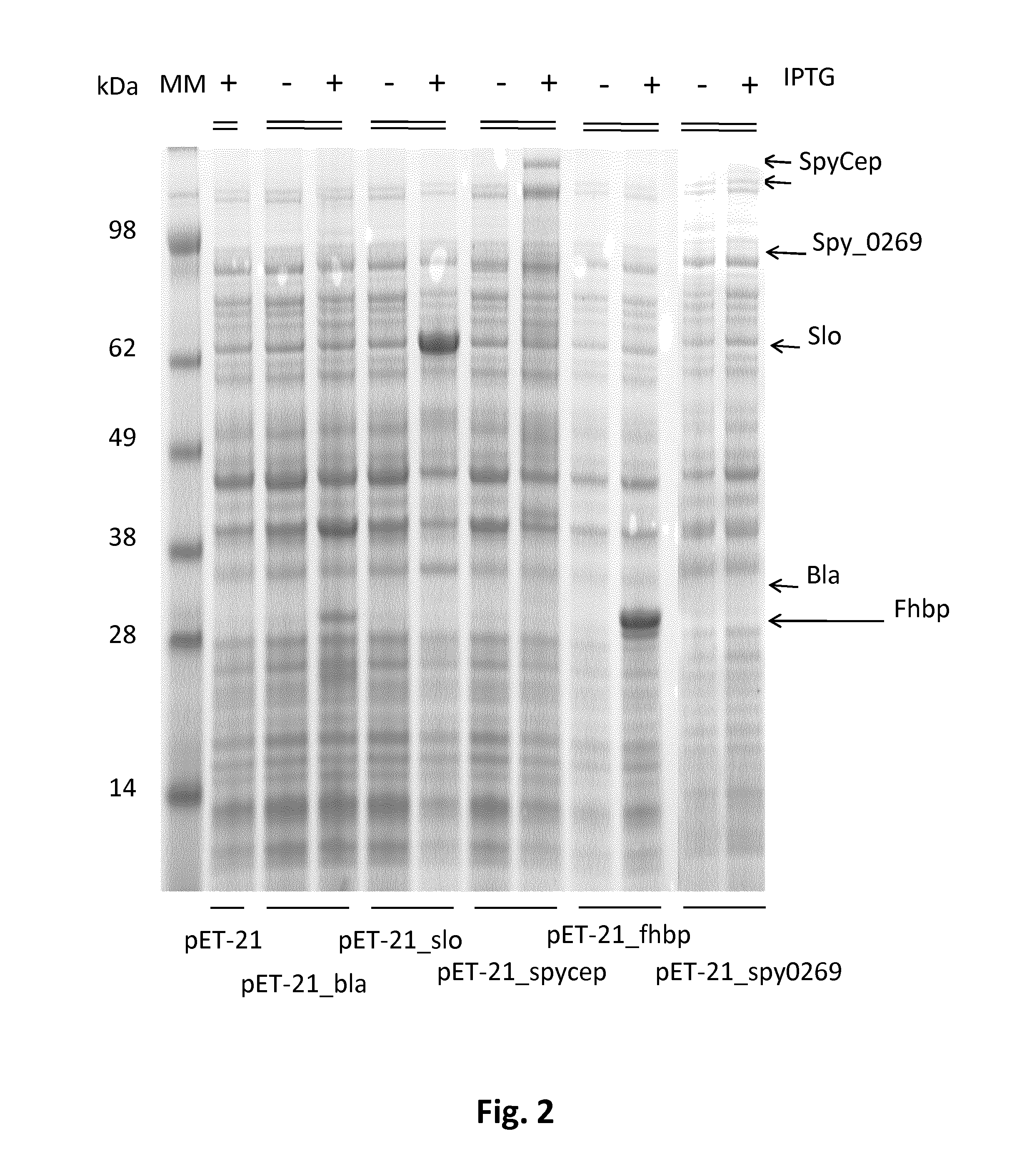Outer membrane vesicles
a membrane protein and outer membrane technology, applied in the field of outer membrane vesicles, can solve the problems of difficult to overexpress a large amount of an integral membrane protein without affecting the transformation effect of the transformed bacterium, and the presence of antibacterial agents that are foreign to the parental bacteria remain notably absent from omvs,
- Summary
- Abstract
- Description
- Claims
- Application Information
AI Technical Summary
Benefits of technology
Problems solved by technology
Method used
Image
Examples
example 1
Expression of Heterologous Proteins into E. coli OMVs
[0213]Generation of E. coli BL21(DE3) ΔtolR and ΔompA ko Mutants
[0214]Recombination-prone BL21(DE3) cells were produced by using the highly proficient homologous recombination system (red operon) [122]. Briefly, electrocompetent bacterial cells were transformed with 5 μg of plasmid pAJD434 by electroporation (5.9 ms at 2.5 kV). Bacteria were then grown for 1 h at 37° C. in 1 ml of SOC broth and then plated on Luria-Bertani (LB) plates containing trimethoprim (100 μg / ml). Expression of the red genes carried by pAJD434 was induced by adding 0.2% L-arabinose to the medium.
[0215]ΔtolR and ΔompA E. coli BL21 mutant strains, which are known to spontaneously produce a large amount of OMVs, were produced by replacing ompA and tolR coding sequences with kanamycin (kmr) and chloramphenicol (cmr) resistance cassettes, respectively. A three-step PCR protocol was used to fuse the upstream and downstream regions of ompA and tolR to the kmr and ...
example 2
Plasmid Construction
[0217]Five heterologous proteins from different bacterial species, both Gram positive and Gram-negative, and belonging to different cellular compartments were selected as model proteins to determine whether heterologous proteins can be incorporated into E. coli OMVs in their native conformations. These proteins included: (1) the periplasmic TEM1 beta lactamase (Bla) from E. coli, (2) the factor H-binding protein (fHbp) lipoprotein from Neisseria meningitidis, (3) the extracellular cholesterol depending streptolysin O (Slo also called GAS25) from Streptococcus pyogenes, (4) the cell envelope serine protease SpyCEP (also called GAS57) from Streptococcus pyogenes and (5) the putative surface exclusion protein Spy0269 (also known GAS40) also from Streptococcus pyogenes. The nucleic acid coding sequences for each of these five proteins were cloned into the pET-OmpA plasmid using the polymerase incomplete primer extension (PIPE) cloning method [123]. The pET-OmpA plasm...
example 3
Expression of the Heterologous Proteins into ΔtolR and ΔompA Mutants, OMVs and Total Lysates Preparation
[0219]In order to investigate whether the Bla, slo, SpyCEP, fHbp and Spy0269 proteins are packaged into OMVs, the ΔtolR and ΔompA E. coli BL21 strains were transformed with the pET-21_Bla, pET-21_slo, pET-21_SpyCEP, pET-21_fHbp plasmids and pET21_spy0269. As a negative control, the ΔtolR and ΔompA E. coli BL21 strains were transformed with the pET-OmpA empty vector.
[0220]All the strains were grown in liquid cultures until logarithmic phase and induction of expression of the genes was carried out by adding 1 mM IPTG (isopropyl-beta-D-thiogalactopyranoside). FIG. 2 shows the SDS-polyacrylamide gel electrophoresis (SDS-PAGE) of total lysates of these cultures before and after induction with 1 mM IPTG. Bands corresponding to Bla, slo, SpyCEP, fHbp and Spy0269 proteins are present in all induced samples and are indicated by arrows. Thus, all five of the tested heterologous proteins wer...
PUM
| Property | Measurement | Unit |
|---|---|---|
| Composition | aaaaa | aaaaa |
| Solubility (mass) | aaaaa | aaaaa |
| Immunogenicity | aaaaa | aaaaa |
Abstract
Description
Claims
Application Information
 Login to view more
Login to view more - R&D Engineer
- R&D Manager
- IP Professional
- Industry Leading Data Capabilities
- Powerful AI technology
- Patent DNA Extraction
Browse by: Latest US Patents, China's latest patents, Technical Efficacy Thesaurus, Application Domain, Technology Topic.
© 2024 PatSnap. All rights reserved.Legal|Privacy policy|Modern Slavery Act Transparency Statement|Sitemap



